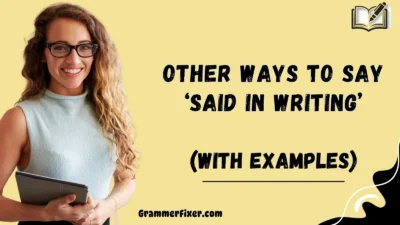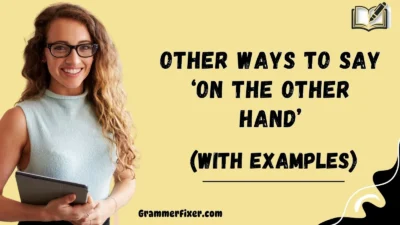Finding the right words to express willingness and openness can make a message feel personal, thoughtful, and engaging. While “happy to discuss” is widely used in professional and casual settings, exploring alternative phrases can refresh your communications, convey genuine receptiveness, and avoid sounding repetitive or robotic.
This guide highlights 30 creative ways to communicate your interest in conversation, ensuring your emails, meetings, or casual chats feel more authentic, vibrant, and approachable.
What Does “Happy to Discuss” Mean?
“Happy to Discuss” is a phrase used to convey openness, willingness, and a positive attitude toward conversation. It signals that the speaker or writer is approachable and ready to engage in dialogue, whether it’s about ideas, proposals, questions, or feedback. This phrase is commonly used in professional emails, meetings, and collaborative settings to communicate receptiveness without committing to a specific outcome immediately.
Using “happy to discuss” helps create a friendly, polite, and constructive tone, making the recipient feel valued and encouraged to share their thoughts or suggestions.
When to Use “Happy to Discuss”?
- When replying to colleagues, clients, or team members suggesting a conversation.
- In emails, calls, or meetings to show interest in exploring ideas.
- To maintain a positive and professional tone while leaving room for flexibility.
Is It Professional/Polite to Say “Happy to Discuss”?
Yes, it is widely acceptable and polite, suitable for formal and semi-formal environments. It demonstrates receptiveness, enthusiasm, and willingness to collaborate, making it ideal for teamwork, client communications, and project coordination.
Pros and Cons
Pros:
- Shows openness and flexibility
- Friendly and professional
- Encourages collaboration
Cons:
- Can sound generic if overused
- May appear formulaic or automatic in repeated communications
1. Glad to Talk
Meaning: Expresses willingness and positive attitude toward conversation.
Explanation: Highlights interest and approachability, slightly more casual than “happy to discuss.”
Scenario Example: “I’m glad to talk through your ideas whenever you’re ready.”
Best Use: Team discussions, friendly emails, casual client interactions.
Worst Use: Formal proposals, high-level executive emails, or legal correspondence where casual tone may seem unprofessional.
Tone: Warm, approachable, enthusiastic
2. Delighted to Converse
Meaning: A more formal and polished way to express willingness to discuss.
Explanation: Adds enthusiasm and appreciation for the conversation.
Scenario Example: “I’d be delighted to converse about potential collaboration opportunities.”
Best Use: Professional emails, partnerships, formal meetings.
Worst Use: Casual chats or quick internal messages where it may sound overly formal.
Tone: Polite, formal, enthusiastic
3. Pleased to Engage
Meaning: Signals positive reception and readiness for dialogue.
Explanation: Conveys professionalism and warmth, suitable for client-facing or executive interactions.
Scenario Example: “I’m pleased to engage on this project and review the next steps.”
Best Use: Business communications, project coordination, strategic meetings.
Worst Use: Casual peer conversations where a lighter tone would be better.
Tone: Professional, cordial, attentive
4. Eager to Chat
Meaning: Shows enthusiasm and readiness to have a conversation.
Explanation: Slightly informal, emphasizing interest and anticipation in discussing ideas.
Scenario Example: “I’m eager to chat about your proposal and explore options.”
Best Use: Internal team discussions, casual client calls, brainstorming sessions.
Worst Use: Formal written proposals or official corporate correspondence, as it may seem too casual.
Tone: Enthusiastic, approachable, energetic
5. Excited to Discuss
Meaning: Expresses strong interest and positive anticipation.
Explanation: Ideal for conversations involving new projects, opportunities, or creative ideas.
Scenario Example: “I’m excited to discuss how we can expand our marketing strategies next quarter.”
Best Use: Creative projects, team initiatives, collaborative planning.
Worst Use: Routine status updates or formal executive emails where enthusiasm may be seen as unprofessional.
Tone: Positive, enthusiastic, motivating
6. Open to Discuss
Meaning: Indicates flexibility and receptiveness without committing immediately.
Explanation: Useful for preliminary conversations or negotiations, showing willingness to hear input.
Scenario Example: “I’m open to discuss your suggestions at your convenience.”
Best Use: Early-stage discussions, negotiation meetings, exploring proposals.
Worst Use: Situations requiring decisive commitment—may sound noncommittal.
Tone: Neutral, approachable, flexible
7. Thrilled to Engage
Meaning: Shows high enthusiasm and strong interest in a conversation.
Explanation: Conveys excitement and proactive attitude, ideal for collaborative projects or new opportunities.
Scenario Example: “I’m thrilled to engage on this initiative and explore potential partnerships.”
Best Use: Creative projects, client proposals, strategic planning sessions.
Worst Use: Routine emails, brief updates, or formal corporate memos where high enthusiasm may appear exaggerated.
Tone: Energetic, positive, approachable
8. Enthusiastic to Exchange Views
Meaning: Expresses eagerness to share ideas and participate in dialogue.
Explanation: Highlights openness, collaboration, and engagement, signaling that all perspectives are welcome.
Scenario Example: “I’m enthusiastic to exchange views on the upcoming marketing campaign.”
Best Use: Team brainstorming sessions, industry discussions, panel conversations.
Worst Use: One-sided updates or short confirmations where exchanging views is not expected.
Tone: Collaborative, positive, inclusive
9. Willing to Speak
Meaning: Indicates readiness to communicate thoughts or ideas.
Explanation: Simple and direct, emphasizing availability and openness without additional enthusiasm.
Scenario Example: “I’m willing to speak on the feasibility of the new project during our next meeting.”
Best Use: Situations requiring neutral, clear communication, such as project updates or committee meetings.
Worst Use: Casual chats where it may sound stiff or overly formal.
Tone: Neutral, professional, straightforward
10. Joyful to Share Thoughts
Meaning: Shows positive and friendly interest in contributing ideas.
Explanation: Combines openness with a warm and human tone, suitable for both professional and casual settings.
Scenario Example: “I’m joyful to share thoughts on the proposed editorial strategy.”
Best Use: Collaborative projects, workshops, informal team discussions.
Worst Use: Highly formal business communications, as “joyful” may sound too casual or expressive.
Tone: Warm, friendly, approachable
11. Ready to Discuss
Meaning: Signals preparedness and willingness to engage immediately.
Explanation: Direct and professional, emphasizing availability and initiative.
Scenario Example: “I’m ready to discuss the draft proposal at your convenience.”
Best Use: Formal meetings, client calls, urgent project discussions.
Worst Use: Informal, casual emails where tone may feel abrupt or overly task-focused.
Tone: Professional, clear, proactive
12. Available to Talk
Meaning: Emphasizes presence and accessibility for conversation.
Explanation: Polite and practical, focusing on scheduling and convenience rather than enthusiasm.
Scenario Example: “I’m available to talk this afternoon regarding the new distribution plan.”
Best Use: Coordinating meetings, confirming availability, client calls.
Worst Use: Situations requiring emotional warmth or enthusiasm; may feel too neutral.
Tone: Neutral, professional, accommodating
13. Keen to Delve Into
Meaning: Indicates strong interest in exploring a topic in depth.
Explanation: Suggests curiosity, analytical thinking, and engagement.
Scenario Example: “I’m keen to delve into the fiscal year strategy and its potential impact.”
Best Use: In-depth project discussions, research sessions, strategy meetings.
Worst Use: Routine or superficial discussions where deep engagement is unnecessary.
Tone: Thoughtful, professional, curious
14. Welcome Discussion
Meaning: Expresses openness and receptivity toward conversation or input.
Explanation: Polite and inclusive, often used to encourage participation or collaboration.
Scenario Example: “We welcome discussion on how to improve editorial workflow.”
Best Use: Team meetings, community forums, collaborative projects.
Worst Use: Private one-on-one conversations where inviting discussion may be redundant.
Tone: Polite, professional, inclusive
15. Glad to Explore
Meaning: Shows willingness and positivity toward examining ideas or possibilities.
Explanation: Conveys open-mindedness and curiosity, suitable for collaborative discussions.
Scenario Example: “I’m glad to explore different approaches to the marketing campaign.”
Best Use: Team brainstorming, client proposals, creative projects.
Worst Use: Routine updates or formal memos where a casual tone may seem out of place.
Tone: Positive, approachable, collaborative
16. Happy to Chat
Meaning: Informal and friendly way to indicate willingness to converse.
Explanation: Light and conversational, creating an approachable and warm tone.
Scenario Example: “I’m happy to chat about your suggestions anytime this week.”
Best Use: Casual internal emails, informal client interactions, small team discussions.
Worst Use: Formal corporate emails or executive communications; may seem too casual.
Tone: Friendly, approachable, casual
17. Delighted to Review
Meaning: Shows enthusiasm to examine or consider information.
Explanation: Slightly formal, indicating both readiness and positive reception.
Scenario Example: “I’m delighted to review the proposal before our next call.”
Best Use: Project updates, proposal reviews, strategic planning.
Worst Use: Quick casual messages or informal chats, where “delighted” may feel exaggerated.
Tone: Professional, positive, attentive
18. Excited to Converse
Meaning: Expresses eagerness to engage in meaningful discussion.
Explanation: Stronger than neutral phrases, emphasizing energy and proactive engagement.
Scenario Example: “I’m excited to converse about the new product strategy with the team.”
Best Use: Creative or strategic meetings, brainstorming sessions.
Worst Use: Routine or transactional updates where excitement is unnecessary.
Tone: Energetic, engaging, positive
19. Open to Dialogue
Meaning: Indicates willingness to communicate and exchange ideas.
Explanation: Professional, neutral, emphasizing approachability and receptiveness.
Scenario Example: “We are open to dialogue on the upcoming partnership opportunities.”
Best Use: Negotiations, community discussions, client conversations.
Worst Use: Informal quick chats; may sound too formal or stiff.
Tone: Neutral, professional, inclusive
20. Keen to Engage
Meaning: Expresses strong interest in participation and interaction.
Explanation: Signals enthusiasm and proactive involvement.
Scenario Example: “I’m keen to engage with the editorial team on the next publication cycle.”
Best Use: Workshops, collaborative projects, strategic meetings.
Worst Use: Small routine updates or transactional emails where enthusiasm may seem unnecessary.
Tone: Positive, proactive, professional
21. Willing to Participate
Meaning: Indicates availability and readiness to be involved in discussion or activity.
Explanation: Clear and neutral, emphasizing collaboration and contribution.
Scenario Example: “I’m willing to participate in the upcoming brainstorming session.”
Best Use: Team meetings, project discussions, community forums.
Worst Use: Informal chats where the phrasing may sound stiff or robotic.
Tone: Neutral, professional, collaborative
22. Eager to Explore
Meaning: Shows enthusiasm and curiosity toward ideas or possibilities.
Explanation: Ideal for creative or investigative discussions, emphasizing interest and engagement.
Scenario Example: “I’m eager to explore new marketing strategies with the team.”
Best Use: Creative planning, research discussions, strategy development.
Worst Use: Routine status updates or formal corporate communications.
Tone: Enthusiastic, curious, collaborative
23. Ready to Converse
Meaning: Indicates preparedness and willingness for a meaningful conversation.
Explanation: Professional and clear, emphasizing both availability and engagement.
Scenario Example: “I’m ready to converse about the proposal details anytime this week.”
Best Use: Client meetings, project discussions, formal communications.
Worst Use: Casual chats or informal emails where tone may feel too formal.
Tone: Professional, clear, approachable
24. Glad to Connect
Meaning: Friendly and open phrase indicating willingness to engage.
Explanation: Conveys approachability and warmth, useful in both professional and casual settings.
Scenario Example: “I’m glad to connect and discuss the new partnership opportunities.”
Best Use: Networking, client conversations, collaborative initiatives.
Worst Use: Highly formal communications or executive memos; may seem too casual.
Tone: Friendly, approachable, positive
25. Happy to Review
Meaning: Indicates willingness to examine or consider information attentively.
Explanation: Professional and polite, showing both readiness and engagement.
Scenario Example: “I’m happy to review your draft before submission.”
Best Use: Project updates, content reviews, proposal evaluations.
Worst Use: Casual internal chats; may feel unnecessarily formal.
Tone: Professional, polite, attentive
26. Thrilled to Share
Meaning: Shows excitement about contributing ideas or information.
Explanation: Enthusiastic and engaging, highlighting positivity and initiative.
Scenario Example: “I’m thrilled to share insights from the recent research with the team.”
Best Use: Presentations, team meetings, workshops.
Worst Use: Routine status updates or highly formal emails.
Tone: Positive, energetic, enthusiastic
27. Open to Feedback
Meaning: Signals receptiveness and willingness to consider input.
Explanation: Professional, collaborative, encourages constructive dialogue.
Scenario Example: “I’m open to feedback on the proposed strategy draft.”
Best Use: Project reviews, client meetings, team collaborations.
Worst Use: Casual emails where requesting feedback is unnecessary.
Tone: Professional, inclusive, approachable
28. Willing to Address Questions
Meaning: Shows readiness to respond and provide clarity.
Explanation: Professional and helpful, emphasizing responsiveness and approachability.
Scenario Example: “I’m willing to address questions about the proposal anytime.”
Best Use: Client calls, team briefings, Q&A sessions.
Worst Use: Informal or casual chats; may sound overly formal.
Tone: Professional, helpful, neutral
29. Glad to Review Options
Meaning: Expresses positive readiness to consider alternatives or suggestions.
Explanation: Polite, professional, and collaborative, signaling flexibility.
Scenario Example: “I’m glad to review options for the upcoming marketing campaign.”
Best Use: Planning sessions, client discussions, project strategy meetings.
Worst Use: Brief updates or casual chats; may feel too formal.
Tone: Professional, positive, collaborative
30. Excited to Explore Possibilities
Meaning: Shows enthusiasm for discovering and considering new ideas.
Explanation: Ideal for creative, strategic, or forward-thinking conversations.
Scenario Example: “I’m excited to explore possibilities for our next fiscal year initiatives.”
Best Use: Creative planning, strategic meetings, innovation workshops.
Worst Use: Routine updates, transactional emails; may feel overenthusiastic.
Tone: Enthusiastic, forward-looking, engaging
Conclusion
Using alternatives to “happy to discuss” allows your communications to feel genuine, warm, and professional. Each phrase conveys a slightly different tone, level of enthusiasm, and context suitability, giving you flexibility to match the message with the scenario.
Key Takeaways:
- Meaning: Choose the phrase that accurately reflects your willingness and tone.
- Best Use: Match your phrase with the context—formal, casual, creative, or collaborative.
- Worst Use: Avoid phrases that feel out of place for the setting or audience.
- Tone: Consider the recipient, relationship, and communication style to maintain clarity and warmth.



